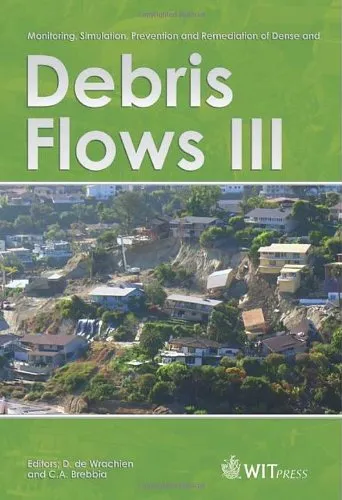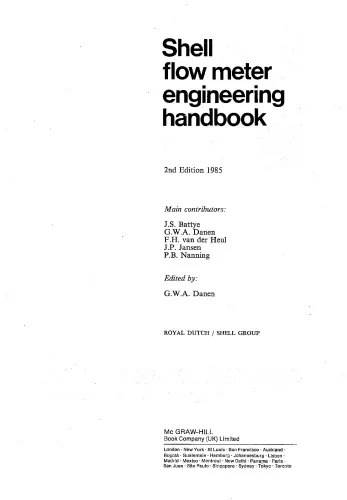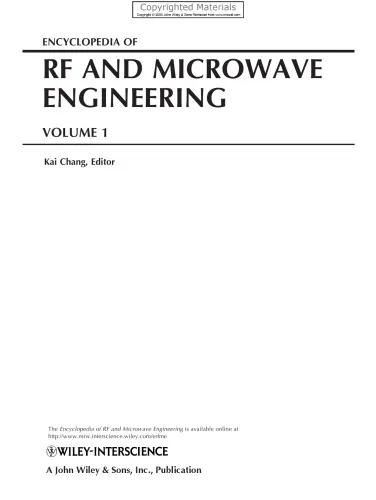Monitoring, Simulation, Prevention and Remediation of Dense and Debris Flow III (Wit Transactions on Engineering Sciences)
3.7
بر اساس نظر کاربران

شما میتونید سوالاتتون در باره کتاب رو از هوش مصنوعیش بعد از ورود بپرسید
هر دانلود یا پرسش از هوش مصنوعی 2 امتیاز لازم دارد، برای بدست آوردن امتیاز رایگان، به صفحه ی راهنمای امتیازات سر بزنید و یک سری کار ارزشمند انجام بدینکتاب های مرتبط:
معرفی کتاب
کتاب "Monitoring, Simulation, Prevention and Remediation of Dense and Debris Flow III" جلد سوم از مجموعهای جامع در زمینه مطالعه و تحلیل جریانهای متراکم و Debris Flow است که به بررسی علمی و عملی این پدیدههای طبیعی میپردازد. این کتاب بهخصوص اهمیت ویژهای برای مهندسان عمران، محققین محیطزیست، زمینشناسان و دیگر متخصصانی دارد که در زمینه مدیریت خطرات طبیعی و مدلسازی جریانهای پیچیده فعالیت میکنند. نویسندگان اثر تلاش کردهاند تا رویکردی بینالمللی و میانرشتهای برای بررسی مشکلات ناشی از این جریانها ارائه دهند و ابزارهایی مناسب برای مواجهه با آنها فراهم کنند.
خلاصهای از کتاب
کتاب حاضر، شامل مجموعهای از مقالات برگزیدهای است که توسط محققین برجسته در کنفرانسهای علمی مرتبط ارائه شدهاند. در این اثر، از مفاهیم مقدماتی گرفته تا تکنیکهای پیشرفته مدلسازی و شبیهسازی جریانهای متراکم، بهطور کامل و دقیق مورد بحث قرار گرفتهاند. محتوای کتاب در چهار بخش اصلی متمرکز شده است:
- روشهای Monitoring برای مشاهده و تحلیل جریانها
- پیادهسازی سیستمهای Simulation برای پیشبینی رفتار جریانها
- اقدامات Prevention برای کاهش خطرات
- استراتژیهای Remediation برای جبران خسارتها و مدیریت پس از وقوع
کتاب همچنین مثالها و مطالعات موردی کشورهای مختلف از جمله مناطقی در اروپا، آسیا و آمریکا را ارائه میدهد. تمرکز آن بر ارائه روشهایی است که به کمک فناوریهای نوین و رویکردهای سیستماتیک، بتوان اثرات منفی رویدادهای طبیعی را کاهش داد.
نکات کلیدی کتاب
مطالعه این کتاب اطلاعات بسیار ارزشمندی در خصوص موارد زیر ارائه میدهد:
- شناخت کامل جریانهای Dense Flow و Debris Flow
- تفاوتها و شباهتهای میان انواع مختلف جریانهای طبیعی
- اهمیت دادههای واقعی در فرآیند Monitoring
- مدلسازی پیشرفته با استفاده از ابزارها و روشهای کامپیوتری
- چگونگی طراحی زیرساختها برای کاهش تاثیر این نوع جریانها
جملات برجسته از کتاب
"Effective monitoring and simulation are the keystones of preventing large-scale disasters caused by debris flow."
"Integrating engineering strategies with environmental insights helps in designing sustainable solutions."
چرا این کتاب مهم است؟
با افزایش وقوع پدیدههای طبیعی از جمله سیلابها و جریانهای Debris، نیاز به راهکارهای مدیریتی و پیشگیرانه بیش از گذشته حس میشود. این کتاب با ارائه محتوای علمی و عملی، به متخصصان کمک میکند تا درک بهتری از این جریانها پیدا کنند، ابزارهای پیشرفتهای برای شبیهسازی و مدیریت آنها توسعه دهند و استراتژیهای موثری برای کاهش خطرات و خسارتها بهکار بگیرند. در مجموع، این اثر یک منبع بینظیر برای ارتقاء دانش و مهارتهای حرفهای در حوزه مهندسی و مدیریت محیط زیست بهشمار میرود.
Introduction to Monitoring, Simulation, Prevention and Remediation of Dense and Debris Flow III
"Monitoring, Simulation, Prevention and Remediation of Dense and Debris Flow III" is a comprehensive scientific resource that addresses the challenges and advancements in understanding dense and debris flows. As part of the prestigious WIT Transactions on Engineering Sciences series, this book builds upon its predecessors to further explore both theoretical and practical approaches to mitigating and managing the devastating impact of dense and debris flows on both natural landscapes and human habitats. By integrating the latest research, advanced simulation techniques, and innovative methods for prevention and remediation, this book serves as an invaluable guide for researchers, engineers, urban planners, geologists, and environmental scientists.
Detailed Summary of the Book
The book delves deeply into the complex phenomena governing dense and debris flows—fluid-like movements of water-soil-rock mixtures that pose significant risks during natural disasters such as landslides, flash floods, and volcanic eruptions. It provides a multi-disciplinary approach to studying these phenomena, incorporating insights from hydrology, geology, engineering, and computational science.
The volume is organized into sections focusing on specific topics, such as the physics of debris flows, mathematical models for simulation, field monitoring techniques, advanced engineering practices for disaster prevention, and strategies for the environmental remediation of affected areas. Each chapter is authored by leading experts, offering cutting-edge solutions and a wealth of case studies from around the globe. These real-world examples provide invaluable context for understanding the challenges of addressing disasters caused by dense and debris flows.
A key feature of this book is its emphasis on sustainability and interdisciplinary collaboration. By encouraging the integration of knowledge from distinct domains, it pushes the boundaries of traditional engineering and environmental sciences.
Key Takeaways
- State-of-the-art monitoring and detection technologies for early warnings in debris-flow-prone regions.
- Robust simulation techniques for predicting the flow trajectory, velocity, and impact of debris flows.
- Preventive engineering measures such as slope stabilizations, drainage improvements, and retention basins.
- Successful case studies offering practical insights into remediation strategies for affected areas.
- Emphasis on balancing development and environmental conservation to reduce long-term risks.
Famous Quotes From the Book
"Debris flows, though devastating in their impact, are reminders of the dynamic nature of Earth's surface and the intricate balance required to coexist with natural processes."
"Prevention is not merely a challenge of engineering; it is also a challenge of foresight, policy, and human collaboration."
Why This Book Matters
Dense and debris flows present significant risks to communities and ecosystems worldwide, often resulting in catastrophic loss of life, property, and biodiversity. This book is critical because it provides evidence-based solutions, pioneering simulation tools, and innovative prevention strategies that can help reduce these risks.
What sets this book apart is its forward-thinking approach to understanding the complexities of debris flows. It not only focuses on disaster management but also offers insights into designing sustainable systems that prioritize community safety and environmental well-being. Given the increasing frequency and severity of climate-related disasters, this resource is more relevant than ever.
Academicians, practitioners, and policymakers alike will find this book a valuable addition to their collections, as it serves as both a strong academic reference and a practical guide for real-world applications. By fostering collaborations between disciplines and presenting innovative solutions, "Monitoring, Simulation, Prevention and Remediation of Dense and Debris Flow III" contributes significantly to sustainable engineering and disaster resilience.
دانلود رایگان مستقیم
شما میتونید سوالاتتون در باره کتاب رو از هوش مصنوعیش بعد از ورود بپرسید
دسترسی به کتابها از طریق پلتفرمهای قانونی و کتابخانههای عمومی نه تنها از حقوق نویسندگان و ناشران حمایت میکند، بلکه به پایداری فرهنگ کتابخوانی نیز کمک میرساند. پیش از دانلود، لحظهای به بررسی این گزینهها فکر کنید.
این کتاب رو در پلتفرم های دیگه ببینید
WorldCat به شما کمک میکنه تا کتاب ها رو در کتابخانه های سراسر دنیا پیدا کنید
امتیازها، نظرات تخصصی و صحبت ها درباره کتاب را در Goodreads ببینید
کتابهای کمیاب یا دست دوم را در AbeBooks پیدا کنید و بخرید
1261
بازدید3.7
امتیاز0
نظر98%
رضایتنظرات:
3.7
بر اساس 0 نظر کاربران
Questions & Answers
Ask questions about this book or help others by answering
No questions yet. Be the first to ask!











